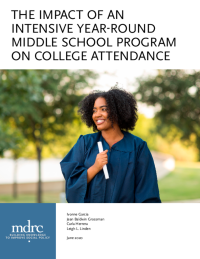The Impact of an Intensive Year-Round Middle School Program on College Attendance

Too many talented students who go to under-resourced schools do not achieve their full potential. Though they may perform very well relative to their classmates, these students do not receive the same kinds of academically challenging opportunities throughout their educational journey as do their counterparts in better-resourced public and private schools. Rather than matriculating to competitive high schools and from there to selective colleges they are qualified to attend, these students often go to less academically competitive high schools and on to colleges where graduation rates are low. Some even forgo college altogether.
To address this problem, Higher Achievement offers an intensive, academically oriented program for middle school students in under-resourced schools. Starting in the summer before fifth or sixth grade, Higher Achievement offers its participants, called “scholars,” 650 extra hours of academic enrichment and instruction after school and during the summers through the eighth grade. The program includes English and math instruction as well as field trips to competitive high schools and colleges, achievement test preparation, and assistance in applying for financial aid. This short report presents the results of a randomized controlled trial of Higher Achievement that started in 2005, comparing the outcomes of students who were offered the opportunity to participate in Higher Achievement (the program group) and students who were not (the control group). It presents the impacts of the program one, two, and four years after enrollment, as well as its long-term impacts on college attendance.
The study found that Higher Achievement was successful at changing the educational trajectory of students through middle school and improved the academic quality of many students’ high school experiences, but did not affect the colleges to which they matriculated. By Year 2, there were positive impacts on students’ math and reading test scores. In Year 4, the impacts on math test scores remained statistically significant. Higher Achievement had a small impact on the types of high schools its scholars ultimately attended. Program group students were more likely than control group students to matriculate to private or parochial schools and less likely to go to nonacademically competitive charter or magnet schools. By 2019, there was no difference in college going. More than 70 percent of both program and control group students had ever attended college. There were no differences in the academic quality of the colleges Higher Achievement’s scholars ultimately attended, as measured by being a two- or four-year college; a college having a lower acceptance rate; or a college whose freshmen on average had higher SAT math or reading scores. Higher Achievement’s college impacts did not differ by whether a student’s parent had attended college or by student characteristics.
The study shows that Higher Achievement is a very effective middle school program, improving students’ middle school trajectories. However, the impacts did not persist after the program through high school and college.






